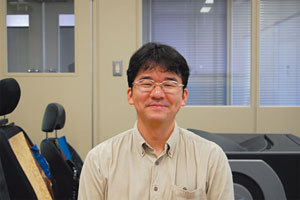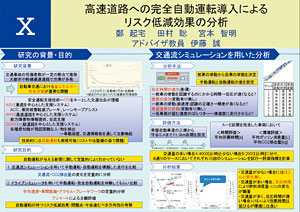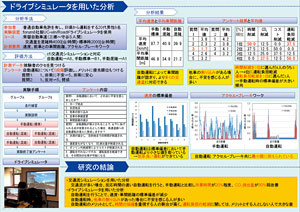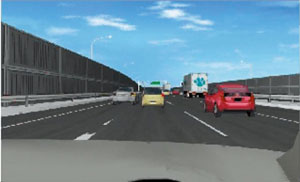Towards Designing New Ways of Human-automobile Interaction Through Forecasting and Controlling Risks: Aiming to Build an Appropriate Support Method from Detecting and Estimating Drivers' Conditions with Free Use of Various Sensors and DS's
In the modern society, we are exposed to various risks ranging from accidents and disasters to the risks that reflect rapid advancement of information communication technology (ICT), contrary to its convenience.
This issue picks up the Risk Engineering Major, Graduate School of Systems and Information Engineering, University of Tsukuba. In response to the needs of the times, the Risk Engineering Major classifies wide-ranging risks into four fields. They are providing flexible and leading education and research dealing with various problems found between occurrences of diverse risks and their solutions. We focus on the efforts made by Laboratory for Cognitive Systems Science led by Professor Toshiyuki Inagaki and Associate Professor Makoto Itoh. The Laboratory specializes in relationships between human beings and machinery, aiming at clarifying properties and mechanism of human cognition and decision making, while utilizing advanced simulation and sensing technologies. Furthermore, they seek for how to support humans with systems in consideration of these results.
In Japan, research and development of measures against traffic accidents is positioned as an important subject. With regard to this subject, the Lab selected a driver-automobile interface as its research theme in the context of studying human cognitive systems. They have been aiming at designing a system for supporting drivers from the vehicle's side by measuring, detecting, and estimating drivers' conditions from various angles. While performing multiple experiments in the process, it was required to get a drive simulator (DS) capable of representing the environments close to the real driving scenes with ease, reflecting diverse needs. For these reasons, FORUM 8's "UC-win/Road Drive Simulator" has been adopted, which is 3D real-time VR (virtual reality) based, and of four-wheeled real-car type.
We interviewed Associate Professor Makoto Itoh from the Lab, who takes the lead in deciding on introducing the DS as well as its utilization.
University of Tsukuba was established in 1973 as a comprehensive university when its forerunner Tokyo University of Education was relocated. After 36 years, the University has expanded to have three campuses in Tsukuba and Tokyo (Otsuka and Akihabara areas), where there are 7 schools (Humanities and Culture, Social and International Studies, Human Sciences, Life and Environmental Sciences, Science and Engineering, Informatics, Medicine and Medical Sciences), 2 special schools (Health and Physical Education, Art and Design), 8 graduate schools (Education, Humanities and Social Sciences, Business Sciences, Pure and Applied Sciences, Systems and Information Engineering, Life and Environmental Sciences, Comprehensive Human Sciences, Library, Information, and Media Studies). There are 10,190 students in schools, 6,556 in graduate schools, 16,746 in total. International students account for 1,527, coming from 101 countries and areas (as of April 1, 2009).
Among them, Graduate School of Systems and Information Engineering comprises Social Systems Engineering, Business Administration and Public Policy, Risk Engineering, Computer Science, Intelligent Interaction Technologies, and Engineering Mechanics and Energy. The first two majors are limited to the master's programs, while Social System and Management is added to the doctoral program.
Furthermore, the Risk Engineering Major consists of four fields with various possible risks in mind: Total Risk Management, Cyber Risk, Urban Risk, and Environmental and Energy System Risk. Each field is treated with multiple laboratories and groups. Their goals are to prepare the students with ability to forecast and control risks in concrete, to contribute to the society through the results of theoretical and applied research, and to display leadership in the field from a global point of view.
Featured in this article, Laboratory for Cognitive Systems Science is positioned in the Total Risk Management field that is interdisciplinary. Its theme is "designing human-machinery relationship". They are studying collaborations between human and computers depending on different situations, as well as human interfaces for realizing them. The approaches to these research themes include: Designing human-machine systems in consideration of human cognitive characteristics and decision-making process, Identification of factors that have effects on operator's behavior through analysis on human-machine interaction using mathematical models of human's decision making, and Modifying mathematical models based on results of cognitive experiments using DS etc. conducting evaluation of the system design from cognitive-engineering aspect.
Formerly, they paid attention to an airplane as a highly automated system involving humans and machines. However, such technologies have gradually been spread into automobiles. On the other hand, though there is a tendency of decrease in road accident fatalities compared to the peak time, the number of accidents is still at a high level. As it is highly expected to develop technology to cope with it, automobile is becoming a main research theme in recent years.
In this point, ITS (intelligent transportation system), for example, is based on the idea of connecting humans, roads, and vehicles via state-of-the art ICT in order to solve road traffic problems. On the contrary, the Lab takes a stance that they focus on a single vehicle in relation with humans, as they say.
As an example to show a part of the characteristics of the Lab, Assistant Prof. Makoto Itoh mentions "Situation and Intention Recognition for Risk Finding and Avoidance", a project for Ministry of Education, Culture, Sports, Science and Technology (MEXT) (Japan Science and Technology Agency: JST) Special Coordination Funds for Promoting Science and Technology - Research and Development Program for Resolving Critical Issues (2004-2006 fiscal years). With Prof. Toshiyuki Inagaki of the Lab as the project leader, a lot of universities and institutes participate this project. For the purpose of stopping "a chain of events" that may cause a traffic accident, and to avoid risks on the upstream of a chain, they develop a mechanism to prevent potentially unsafe situations of a driver, such as careless driving, and to promote the driver to return to safe driving behavior in an early stage even if such a situation occurs.
In this project, they examined whether there is inconsistency between the situation and the driver's intention that may cause a risk. First, they observed drivers while driving and the situation outside. "The previous systems only looked at the outside, not capable of taking the driver's condition into account." However, when it comes to supporting drivers, appropriate support should be provided after measuring, detecting, and estimating drivers' conditions such as their awareness, cognition, judgment, and operation depending on outside situations. In other words, how to estimate the drivers' condition was a key factor.
"To know the driver's condition" and "how to support" depending on the degree of risks faced by the drivers and how much time is left are regarded as important subjects in the Lab now. It is assumed that types of support may vary from mild approaches such as an alarm device or a reminder to a system that applies the brakes on behalf of the driver. It is therefore necessary to theoretically examine how far a system may intervene in control for safety, and what will happen when a vehicle is loaded with such functions. At the same time, it is required to see how drivers feel about each support and what kind of behaviors they take respectively. For such purposes, the Lab has been using DS so far to estimate drivers' condition and to confirm support.
On the contrary, with regard to supporting methods, they are examining the system design, for example, when the brake should be used by force in the case that something else is diverting a driver's attention under imminent danger of collision, to take for instance. In Japan, as the basic concept of ASV (Advanced Safety Vehicle), a system is not allowed to intervene unless the driver expresses his or her will to use the brake. In actual circumstances, however, when collision is likely to occur with high certainty, it is exceptionally allowed as long as it is for mitigating damage (e.g. by precrash safety system). However, as a foreign automobile manufacturer realized forced intervention in a low-speed range, efforts have been required to promote new development in a high-speed range. For this purpose, they also cooperated with people outside the university. They are working on forming a theory of avoiding drivers' overtrust as well as on evaluations of the risks of physical collisions.
They plan to integrate these studies in the end, estimating drivers' situations, and designing a system. At the same time, they consider that good management should be performed so that drivers may not overtrust the system.
The Lab has been utilizing DS from an early period for experimental use. One is a stational type limited to expressway courses. Another one is a system with motion function having urban area courses in addition to expressways. Both systems had advantages respectively, having ready-made courses for example and being available right after installation. On the contrary, however, though there was an increasing need for conducting experiments by setting up various situations, they could not meet the need easily.
Against this backdrop, Prof. Makoto Itoh turned his attention to "UC-win/Road Drive Simulator" of our Company. Finally, they introduced it in 2007.
Then after the completion of the above research project, he equipped the DS with a pressure distribution sensor and used it in the process of working on the research project "Towards Socially Acceptable Forward Vehicle Collision Avoidance: Adapting Autonomy via Non-intrusive Driver-monitoring" supported by Grants-in-Aid for Scientific Research of MEXT (Japan Society for the Promotion of Science: JSPS), led by himself. He is also planning to use the DS in another research project of the same Grants-in-Aid for Scientific Research, "Human-machinery double centered management of multi-layered collision avoidance in natural driving situations" (2009 - 2011 fiscal years), which has just started.
In parallel with this, in the research "Analysis of risk-reducing effect through adopting full-automated driving in expressways" conducted in the class for the Risk Engineering Major in the first half of this year, one of the students modeled a section of 11.3 km between Misato Tollgate and Moriya SA within about a month including time for training how to use it. Based on this model, analysis is being conducted using DS.
"I believe that no other DS couldn't have made it possible to create the course in such a short time, and to represent topography with high accuracy." Based on a series of usages of our DS's, Associate Professor Makoto Itoh says that he would like to make the most of them in studies including those in this fiscal year.
We are most grateful to everyone involved for spending time with us for the interview.








